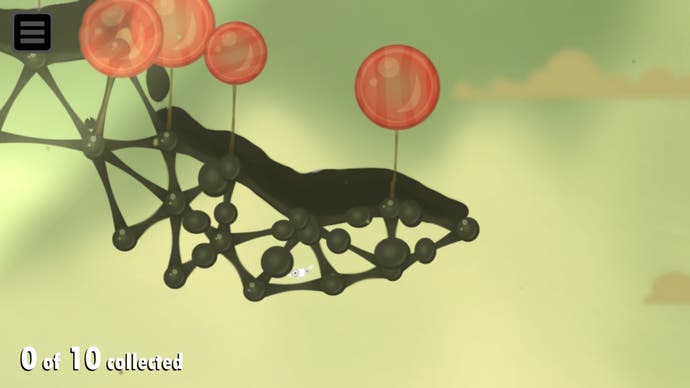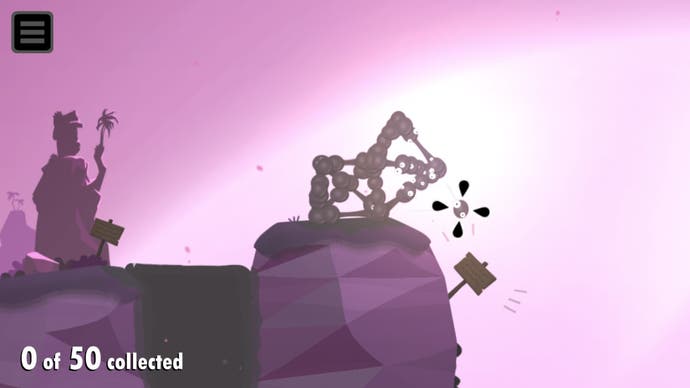The spirit of Buster Keaton flies again in World of Goo 2
Every frame a finger painting.
I'm not sure how funny Buster Keaton movies are these days - I assume there are moments that still work as pure gags. But these films of his remain wonderful, because Keaton was kind of the Tom Cruise of his age - or rather Cruise, who namechecks Keaton often in interviews - is the closest thing we have to the original. Keaton's gags were almost always stunts, dangerous, brilliant, clearly visual stunts that moved the action forward while giving audiences something to gasp at. There's nothing on the surface to make me think of the World of Goo games, and yet I think of Keaton constantly when I play.
Keaton's world moves. I think that's it. Its physics are dependable - and predictable, which is important for gags and for games - but the ground itself cannot be trusted. If Keaton's sat on a steamboat's wheel and he thinks he's safe, we know that wheel's going to start turning. If he's climbing a ladder, we know that the ladder itself will start sinking into the mud. What then? Keaton has to vamp - to make the moment work. He has to over-engineer things to create a sense of new stability. That's where you get the gag, where you get the fun.
This is everywhere in World of Goo. At the heart of the first game, which helped usher in the Indie era, and at the heart of the second, which has just arrived, bringing with it both new ideas and a lot of fond memories - at the heart of both you're dealing with treacherous foundations. These games are bridge builders at their simplest. (Granted, they never stay simple for very long.) You have a pile of black goo lumps, and you can extend the lumps outwards to create rudimentary frames. The goal for each level is a pipe you have to reach, which will suck in any remaining goo balls. So build upwards in a tower to a pipe that's lurking above you! Build outward as a bridge across a nasty gap.
But Buster Keaton physics are waiting. You're not building with steel, remember. You're building with goo. So those towers and bridges start to sway as they get more elaborate. And then they start to properly swing back and forth. You know the moment is coming, you know it's almost like a sigh - there it is! The whole thing ripples down through the air and sags to the ground. Even in collapse it retains a sort of spirit of rigidity, though, so what do you do? Build more? Try to boss the whole structure back to life? Chuck on the appendages? Emulate the pyramid? Reinforce the bridge and get it arcing back out over open air once again?
This is the game. You're building, but the world won't stay still. The ladder wants to sink into the mud, the ship's wheel wants to keep on rotating. This world, someone said, and I believe it was Melville, is a moving one. This alone is why World of Goo can wait, what, more than a decade between installments. Its playful brand of irritant will never go out of style, just like Buster Keaton. We need stuff like this to drive us to fury, and then to drive us to overcome our fury.


This is the very basis of the game design, anyway. From there, World of Goo 2 adds special goos. It did this in the first game, and it's still doing it now. It loves variation, it lives for the one-shot gimmick. I'm not going to pretend to be able to remember where I first encountered each kind, but in the early stages of the new game, I loved the absorbent goo, which formed clear pipes and Bucky Balls and allowed me to draw up oil from one part of the screen and lob it somewhere else, where it might prove more useful. I loved the oil! All that lubricating gunk to fling around and keep things moving. I also sensed huge Buster Keaton energy in the balloon goos, which you can use to send a structure lofting into the sky, or you can just place, in one brilliant level, at points along a sagging bridge to turn it into a triumphant arch.
Why am I registering Keaton here? The readable physics, for one thing, the balloon physics of up and down that even a kid would understand. But also the sadness, in a way, the slow resolute manner in which the balloons come together to grimly take the weight of this otherwise doomed structure. And then how enduringly silly it all looks at the end. A bridge held aloft by balloons.

This is all just from the first world of the game, mind. Beyond that lie all manner of new ideas. Cheese. Jelly. None of that stuff particularly edible. An escort mission, but you're escorting slime! An entire world where the game seems to push through its own boundaries and achieve very different shapes. A level - my favourite of all I've played so far - where you have to build a tower on a circle of rock. It's a bit like working on the RKO logo, except the whole thing rotates.
The first game brought this kind of mentality: physics, playfulness, gimmickry. This was the other half of the indie revolution...
And this fits, because the first game brought this kind of mentality: physics, playfulness, gimmickry. This was the other half of the indie revolution, at least in my simplifying memory: the other side of the coin to Jonathan Blow's Braid with its teasing, tortured, brilliantly simple puzzles. Two kinds of cause and effect back then: the physicist and the pratfalling clown, who is also a physicist.
The more I played World of Goo 2, though, the more something caught on my brain and nagged at me. Buster Keaton again. His movies are all about simple things going wrong, and the complex things that emerge when trying to set them right again. This is World of Goo, too. That plan didn't work, but rather than start over, what if I just...

And the more I thought of this, the more I wondered about the game's optional challenges. There they are hidden on a menu: save the most goo, use the fewest moves, do it all as quickly as possible. All admirable, but also all weirdly playing exactly across the game design and circumventing, if you ask me, the things that make the game most fun.
I think it's cool that there's this optional suite of things that encourage you to play the game with efficiency, sure. But I want to remember at all times that playing the game with efficiency is rarely going to spark joy, as Marie Kondo might put it. Sparking joy in World of Goo is all about playing with maximum inefficiency: hundreds of moves, loads of vestigial limbs sticking out of every structure by the time it finally collapses for good, goo balls sacrificed for stupid ideas that would never work and just flung, clumsily out into the void. Levels that I have let run and run for minutes, hours even.
Is this the way you're meant to play? I think the success of World of Goo, the thing that makes it feel as relevant today as it was back at the start of modern indies, is that there's no right way. Just as there's no right way to approach Buster Keaton movies: is he a clown, or is he the precursor to Ethan Hunt of the IMF (not that one)? Only one way to find out. Grab that ladder. Let's go.
A copy of World of Goo 2 was provided by Tomorrow Corporation.


